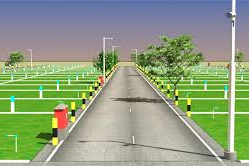
As more and more skyscrapers rise in big cities, satellite areas and even small towns, both during and after the pandemic, there's a noticeable increase in the desire for plots of land and independent floors. But why there is demand for residential plots and independent floors over residential apartments? Let's dive in.
These days in India, there are mainly two types of homes:
Multi-storied buildings: These buildings have several floors, typically ranging from 15 to 20 stories high. Each floor usually contains 4 to 6 separate flats or apartments. Within a complex or enclosed area, there may be several of these multi-storied buildings, often referred to as towers, creating a small community-like environment.
Multi-storied residential buildings are relatively new in most cities, having gained popularity over the past 20 to 30 years. Many people now prefer buying apartments or flats in these buildings for various reasons.
The second type of homes are those constructed on independent plots and floors. These houses aren't part of a single skyscraper but are built on their own designated plot of land. While a house on an independent plot can have multiple floors, typically all the floors are owned by one family.
Though there have been cases where different families have purchased different floors, most commonly, the entire unit belongs to a single family.
Why is there an increased demand for plots and independent floors?
The demand for plots and independent floors is on the rise due to several reasons. Firstly, houses constructed on independent plots and floors are quicker to build. Additionally, there's more freedom in terms of architectural design. Moreover, there's a higher level of accountability among both developers and owners.
Some developers are also favoring projects involving plots and independent floors over multi-storied apartments because it improves their cash flow. With apartment projects, only large builders with substantial funds can invest, as homeowners typically don't pay in a lump sum. However, with plots and independent floors, builders can receive payments faster since these projects can be completed more quickly.
The recent pandemic has contributed to the increased demand for plots and independent floors. With more people working from home, the need for extra space has grown. While some have improvised home offices on apartment balconies, this isn't a sustainable solution. Independent floors and plots offer the advantage of easier expansion, allowing for additional rooms or offices.
Moreover, there's a concern about the spread of infection in congested apartment buildings where common amenities like lifts and doorways are shared. In contrast, plots and independent floors offer more open spaces, better ventilation, and direct access to the road, reducing the risk of infection transmission.
Due to the heightened demand for residential plots, they are experiencing a higher compound annual growth rate of 7% compared to 2% for multi-storied building apartments. This translates to a higher return on investment for homeowners and investors. However, if preferences shift towards multi-storied buildings in the future, they too could yield a higher ROI.
Why do some people prefer apartment buildings?
In major cities such as Delhi-NCR, Mumbai, Pune, Bengaluru, Hyderabad, Chennai, and Ahmedabad, many people still prefer apartments in multi-storied buildings for practical reasons. These buildings offer various shared amenities like swimming pools, health centers, maintenance services, and power backup.
Security measures are often better in apartment complexes, with features like a common wall surrounding the complex and dedicated parking areas. Additionally, there's usually a spacious garden area for children to play in.
On the other hand, independent plots and floors often lack these communal facilities and residents must make their own arrangements, especially for power backup and security.
Cities like Hyderabad, Bengaluru, and Chennai are witnessing a significant surge in demand for residential plots and independent floors. Between 2018 and 2021, these cities experienced double-digit growth in property prices.
For example, Hyderabad saw a remarkable 21% increase in property values during this period, with areas like Shankarpalli, Patancheru, Tukkugudu, Maheshwaram, and Shadnagar witnessing the highest rise in demand. Similar trends have been observed in Chennai and Bengaluru.
In the northern region, Gurugram stands out among the Delhi-NCR areas, with independent plot prices rising by 15% between 2018 and 2021. Additionally, Lucknow has also seen a noticeable shift towards independent plots and floors.
Compared to independent houses and residential plots, the prices of multi-storied building apartments are rising at a slower pace, around 2-3%, indicating weaker demand for this option.


